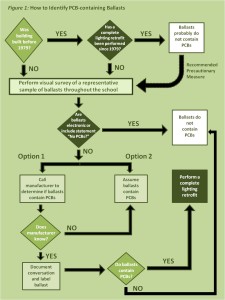In addition to conducting a hazardous waste determination on your lamps which may exhibit the hazardous characteristic of Toxicity for either Lead (D008) or Mercury (D009), you must also determine the hazardous waste status of the lamp ballasts. There are two possible constituents of a lighting fixture’s ballast that may affect its disposal: Polychlorinated Biphenyls (PCBs) and Diethylhexyl Phthalate or Di (2-ethylhexyl) phathatlate (DEHP).
Most ballast manufactured prior to 1979 contain PCBs while some manufactured from 1979 to 1991 contain DEHP. This change came about due to a USEPA ban of the manufacture of PCBs which went into affect at the end of 1979. Further complicating the issue is that the requirement for manufacturers to label non-PCB ballast after 1979 expired at the end of 1989, therefore it’s possible for a non-PCB ballast manufactured after 1989 to lack the “No PCBs” label.
See below for information that will assist you in determining if your fluorescent lighting ballast contains PCBs, DEHP, or neither.
- If manufactured through 1979 and not labeled “No PCBs” assume it contains PCBs.
- If manufactured through 1979 and labeled “No PCBs” assume it is non-PCB.
- If manufactured after 1979 and through 1989, it should be labeled “No PCBs” and may be assumed to be non-PCB.
- If manufactured after 1989 it should be non-PCB but may not be labeled “No PCBs”.
- If manufactured after 1979 through 1991 it may contain DEHP.
A determination of this sort always makes me uncomfortable as it relies on information provided by someone else (the manufacturer) and requires you to make assumptions. In a situation like this, “better safe than sorry” is my advice and that of the USEPA; on its website (Proper Maintenance, Removal, and Disposal of PCB-Containing Fluorescent Light Ballasts) USEPA recommends that whenever a ballast lacks the “No PCBs” label it is best to assume it contains PCBs unless the manufacturer is able to confirm otherwise. This therefore could affect your management of ballast manufactured prior to 1979 and those manufactured after 1989 that may not contain PCBs but lack the “No PCBs” label.
The determination of the presence of DEHP in ballast is also based on limited information. DEHP has been found in certain ballasts designed for the following light fixtures:
- Four-foot fluorescent fixtures manufactured between 1979 and 1985.
- Eight-foot fluorescent fixtures manufactured between 1979 and 1991.
- High-intensity discharge (HID) fixtures manufactured between 1979 and 1991.
Not all ballast manufactured from 1979 to 1991 contained DEHP. The only way to be certain is to contact the manufacturer or submit the ballast to a lab for analysis.
What should you do if your ballast contain PCBs or DEHP or you assume that they do?
PCB ballast are not regulated under RCRA as a hazardous waste, but instead are subject to the regulations of the Toxic Substances and Control Act (TSCA). Under TSCA, unless you are a manufacturer of PCB ballast you may dispose of small (<3 lb of dielectric fluid), non-leaking PCB ballast in a municipal solid waste (MSW) landfill. Neither I or the USEPA recommend this however, so once again I refer you to the USEPA website for their recommended disposal practices: Proper Maintenance, Removal, and Disposal of PCB-Containing Fluorescent Light Ballasts.
DEHP is a U-listed hazardous waste (U028), but only as a pure, unused commercial chemical product. After it has been used as a ballast, it will no longer meet the description for a U-listed hazardous waste. Therefore, unless the DEHP-containing ballast exhibit a characteristic (ignitable, corrosive, reactive, or toxic) it may be disposed of in a MSW landfill (RO 11842).

Please don’t hesitate to contact me if I may be of any assistance to you.